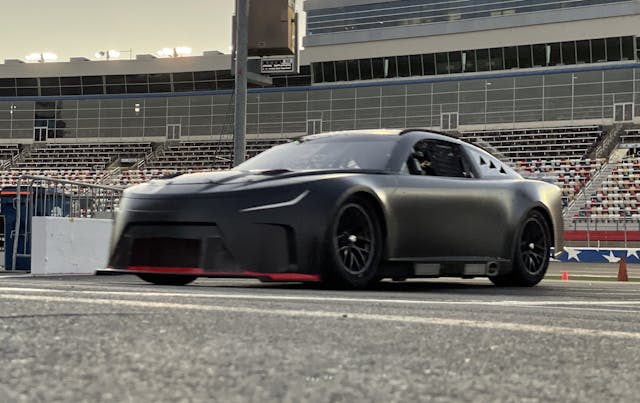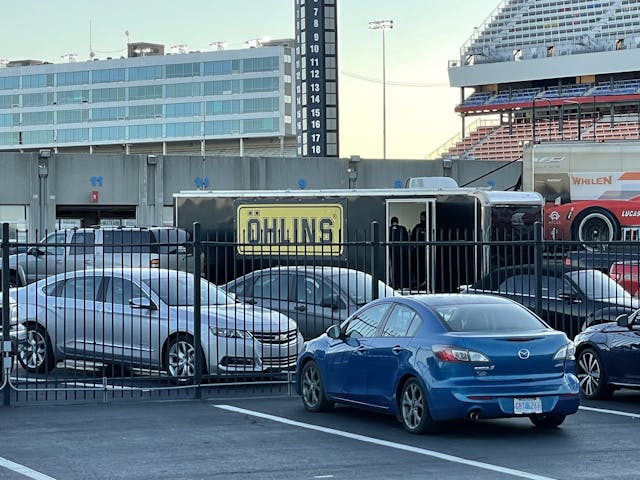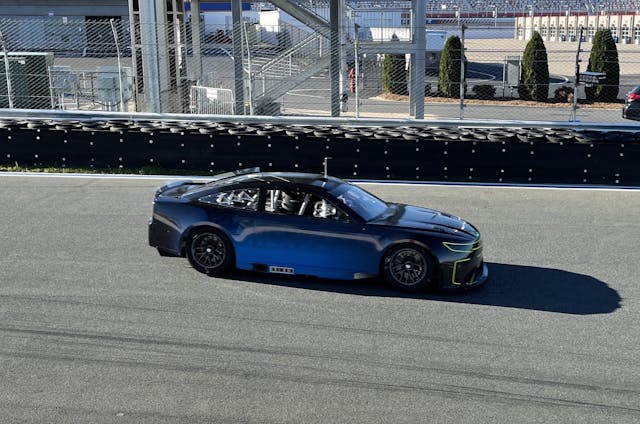Our closest look yet at the NASCAR Next Gen prototype

This week, NASCAR brought its Next Gen prototype out for multi-car tests at Charlotte Motor Speedway. Two evaluations were completed by Martin Truex Jr. and Kurt Busch, using the Roval layout Monday and the oval on Wednesday. Truex Jr. tested a black car built by Action Express racing, while Busch tested the blue “P3” prototype built by NASCAR and Richard Childress Racing. We were able to visit the track on Monday to observe the Roval test directly, yielding some important new details about the Next Gen car.
One of the more noticeable changes we can expect for the Next Gen is the sound of the exhaust. While these prototypes retain engines that are currently being used in the NASCAR Cup series, the exhaust layout is completely different. Current Cup cars have exhaust headers that are closely coupled to the engine before going directly under the car, meeting at a crossover pipe and exiting below the passenger’s door. The Next Gen car deviates from that layout; each bank of cylinders is now independent and the piping never goes under the vehicle.

Instead of going straight back, the exhaust piping makes a turn towards the wheel well as it comes of the headers and goes behind the side skirt area before coming to an outlet on each side. The presence of vents on the side skirts—which are there to help release heat from the pipes behind them—confirm this. It’s a common design on some front-engined GT3 cars and partly comes into play due to aerodynamic enhancements under the car. Most likely, however, the layout is influenced by the need for driver comfort as well as requirements for safety. The current Cup cars get very hot inside, and a large contributor are those pipes that run underneath the cabin, below the driver’s feet. This new design eliminates that issue, which should reduce in-cabin temperatures greatly and reduce some of the foot burns that we’ve seen in the past.

One of the aerodynamic changes that contributed to the new exhaust design is the presence of a flat floor underneath the car—something we were able to visually confirm as the car passed from the pits to the garage. The flat floor extends from the splitter at the front to the diffuser in the rear, representing yet another characteristic shared with many current GT3 cars. The current cars feature a radiator pan or splitter extension panel that sits behind the splitter, along with aerodynamically optimized suspension and engine components under the car meant flatten it out. The new car, however, closes everything off and places flat panels underneath. This change will smooth out the airflow underneath the car, but the more important factor is that it will reduce development costs; large teams have spent a lot of effort on researching and developing components underneath the car to be more aerodynamically efficient, because splitter size and shape has been limited by the rules.
First day of @NASCAR #NextGen testing, @CLTMotorSpdwy Roval. She was nice! pic.twitter.com/xyrO9eMSCQ
— Kurt Busch (@KurtBusch) November 16, 2020
Video from the garage released by Kurt Busch (above) gives us a closer look behind the wheels, and it confirms a rack-and-pinion steering setup. The rack appears to be mounted towards the front of the engine, which puts it ahead of the wheels. The steering rack appears to be a Woodward design, based on what we could see from the casting, which is not a surprise given Woodward supplies similar designs for a variety of other race cars. Early comments about the steering rack showed it to be twitchy, and we checked in with Busch and Truex Jr. to get their feedback. Both were happy with how responsive the rack was on the road course section, but it sounds like more work is in order to keep it stable on the oval.

Xtrac and Öhlins support vehicles were present in the garage area, which helps to confirm our earlier predictions for gearbox and damper suppliers. Both cars that were present for the test were using sequential transaxles, but it appears that the blue car may have had a modified unit based on how it sounded after taking off each time. It is likely that Xtrac and NASCAR have worked together to make improvements to the original design, which was borrowed from Australian Supercars. Judging by the sound coming from blue car as it got up to speed, gearing changes are likely, but NASCAR was not able to confirm anything related to the transaxle.

The Next Gen prototypes appeared to be quite a bit faster on the road course section than the current cars. That’s not much of a surprise, considering the independent suspension and layout of the vehicle which more evenly spreads some of the weight. On the other hand, they appear to still need a little work for the oval sections—especially as the cars transition from the oval to the road course sections where they appeared to occasionally suffer some splitter impacts.

We observed the Next Gens running in the 84-second range for most of the day, with a couple of 83.9 laps sprinkled in. This puts them about three seconds slower than the 2019 Roval pole qualifying time and about a second faster than the fastest lap in the most recent Roval playoff race. All reasonable, given our understanding that the Next Gen prototype weighs slightly more than the current car, plus the fact that it ran with around 100 fewer horsepower, per Busch. The focus of the day was, ultimately, not to seek speed but to collect data for NASCAR. We can expect those times to get quite a bit better once crew chiefs and engineering teams commence tuning efforts.
Seeing the car up close helped to confirm many of our previous predictions, and it demonstrated that NASCAR has been implementing improvements over time. We look forward to additional tests soon, so keep following along for additional details as they become available.

